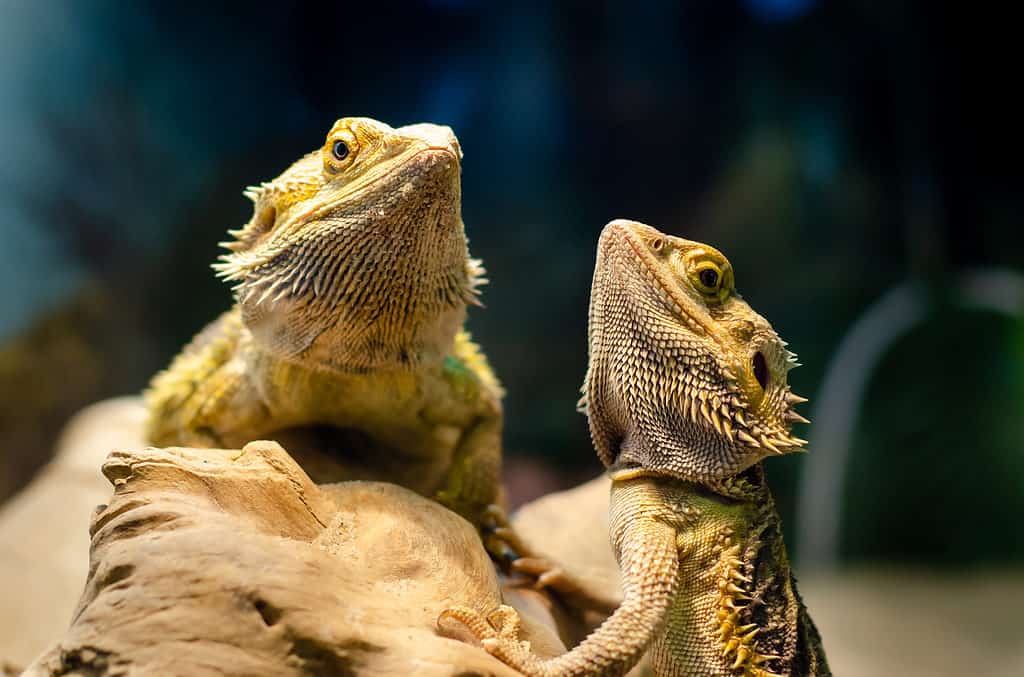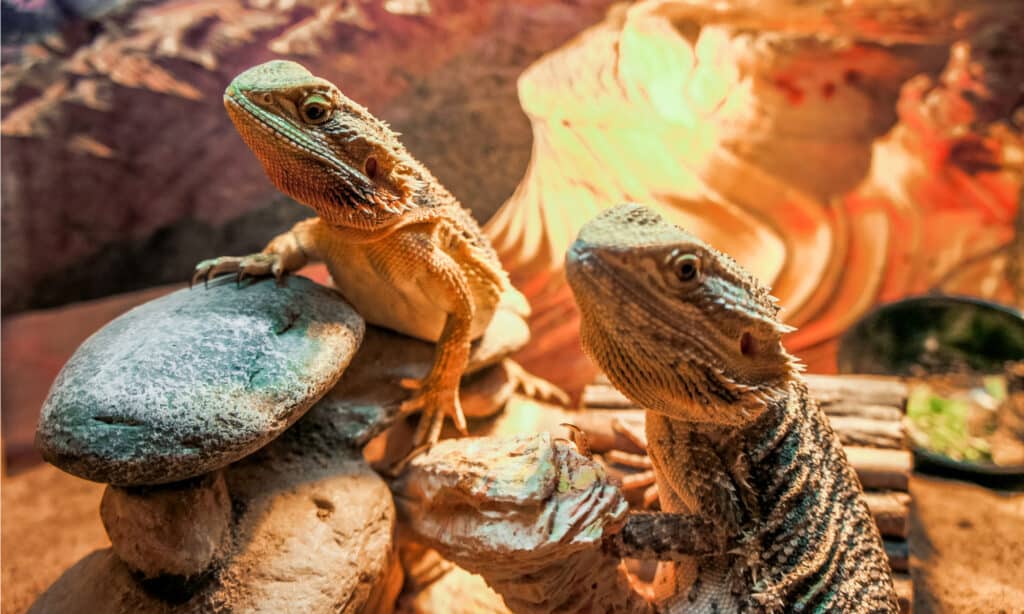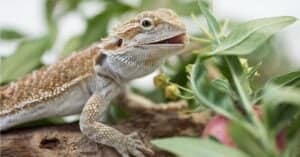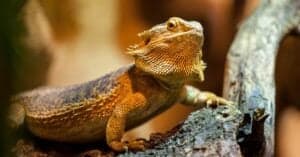One of the most common pet reptiles is the bearded dragon. But do you know who’s the oldest bearded dragon ever recorded? Plus, what’s their expected lifespan? We’ll explore these questions and more below.
What is a Bearded Dragon?
Bearded dragons include 6 species of lizards in the genus Pogona. They’re originally from arid parts of Australia and therefore thrive in warm temperatures. Lizards are cold-blooded; their environment, therefore, dictates body temperature.
These reptiles are somewhat arboreal and spend some of their time perched in trees. They’re usually brown or tan though they come in various colors in the pet trade. They brumate in the winter, which is a reptile version of hibernation.
Bearded dragons regularly reach 2 feet long in captivity. Growth can be stunted if inappropriate animal care is practiced. Bearded dragons are common pet lizards, and they get their name from their hairy-looking chin.
The Oldest Bearded Dragon
The oldest bearded dragon reached 18 years of age and died on January 24, 2016. He was a male inland bearded dragon. The lizard was born on June 1, 1997, and lived in Middlesex, UK.
His owner was Lee-Anne Burgess, and the dragon’s name was Sebastian. Some unverified rumours exist that other bearded dragons reached 20 years of age before passing away. While it’s possible, these lifespans are unverified.
Sebastian was purchased on Christmas Eve, which worked well for him but can end badly for many pets. If you’re considering giving someone a pet for Christmas or any other holiday, consider whether that person wants a pet. Pets are a huge money and time commitment, so not everyone is prepared to take on that extra responsibility.
Expected Lifespan

Bearded dragons are usually brown or tan, although they come in various colors in the pet trade.
©Lutsenko_Oleksandr/Shutterstock.com
Most bearded dragons live around 5 to 7 years, with some making it past 10 years old. These statistics vary slightly between species, and males tend to live longer than females.
Some morphs, due to inbreeding, have a shortened lifespan because of genetic diseases. Silk backs are an example of a well-known morph having many health issues.
How to Increase the Lifespan of Your Bearded Dragon
Increasing the lifespan of your lizard may be possible if you ensure your dragon is well cared for and has all the requirements for a thriving life. This means that you care for your pet without making basic mistakes. Environment, diet, and exercise routines greatly affect the lifespan of pets.
This companion needs a large enclosure. Most need at least 4 feet of tank length, and their environment must remain dry and warm. In addition, One side of the enclosure needs to be warmer than the other.
Bearded Dragons are omnivores and therefore require a balanced diet. Gut-loaded, dusted crickets, fresh produce, and the occasional treat make up a good diet.
However, please remember that It’s easy to overfeed lizards, which can lead to obesity and shorten their lifespan. While mealworms are easy to obtain and store, they’re high-fat and must be limited.
Leafy greens should always be available to your lizard, and bugs should be offered almost daily. A couple of times per week, a variety of vegetables should be given to the lizard. Fruit is a part of their diet but should be offered sparingly at about once per week.
You’ll need to clean up their large enclosure daily, which can take up to 15 minutes. If their environment is unsanitary, lizards risk contracting parasites, mouth rot, respiratory diseases, and viruses.
It’s important to ensure enough water for both soakings when too hot and drinking. Shade must also be available so the lizard can better regulate its body temperature.
Getting a heat gun is a great way to ensure that temperatures are appropriate for your pet. Common mistakes to avoid are providing too many insects and not enough vegetables, letting the tank get too hot or cold, and not providing enough shade.
Types of Bearded Dragons

Bearded dragons need a large enclosure. Most need at least 4 feet of tank length, and their environment must remain dry and warm.
©Steve Buchus/Shutterstock.com
There are about seven species of bearded dragons today. Different morphs are hitting the market regularly as breeding continues in the lizard community. The inland bearded dragon is the species you’ll encounter the most.
The types of bearded dragons on earth are:
- Western (Pogona minor)
- Inland (Pogona vitticeps)
- Eastern (Pogona barbata)
- Northwest (Pogona mitchelli)
- Rankin’s (Pogona henrylawsoni)
- Kimberley (Pogona microlepidota)
Are These Lizards Good Pets?
Yes, bearded dragons make good pets. They’re tame, have simple needs, and handle being held well. They also live for many years, so it’s important to ensure you’re ready for the commitment.
Bearded dragons originally lived in Australia though it is illegal to harvest wild individuals today. Any bearded dragons sold through reputable vendors outside the country are bred in captivity.
While it’s possible to breed these lizards, it’s not recommended unless you are well-versed in the process. Juvenile bearded dragons are cheaper than adults, but they require more work.
Young lizards are around 50 dollars, while adults are over 100 dollars. Adult lizard habitats are more expensive and cost around 400 dollars or more. DIY tricks make it a little cheaper, like using pottery as hiding spots, harvesting clean wood as perches, and sometimes using newspaper as a substrate.
What Does Gut Loaded and Dusted Mean?

A pet bearded dragon makes a great family addition.
Gut loading an insect means that insects fed to a lizard have just eaten a nutritious meal. Their gastrointestinal tract is full of plant matter. Dusted, on the other hand, means the insect is covered in a white powder that contains calcium, phosphorus, Vitamin D, and Vitamin A.
Regular human food is used to gut load insects at home. Carbohydrates are offered in the form of grains like oats. Vegetables provide the water your feeder bugs need.
A gut-loaded insect better emulates the bugs that a bearded dragon finds in nature. Since bugs in nature forage and are opportunistic, wild insects eat a varied diet that exposes their body to an array of nutrients. Commercially produced bugs eat an unvarying food source meant to bulk them up, which means their nutritional quality suffers.
Up Next
The photo featured at the top of this post is © Lutsenko_Oleksandr/Shutterstock.com
Thank you for reading! Have some feedback for us? Contact the AZ Animals editorial team.







